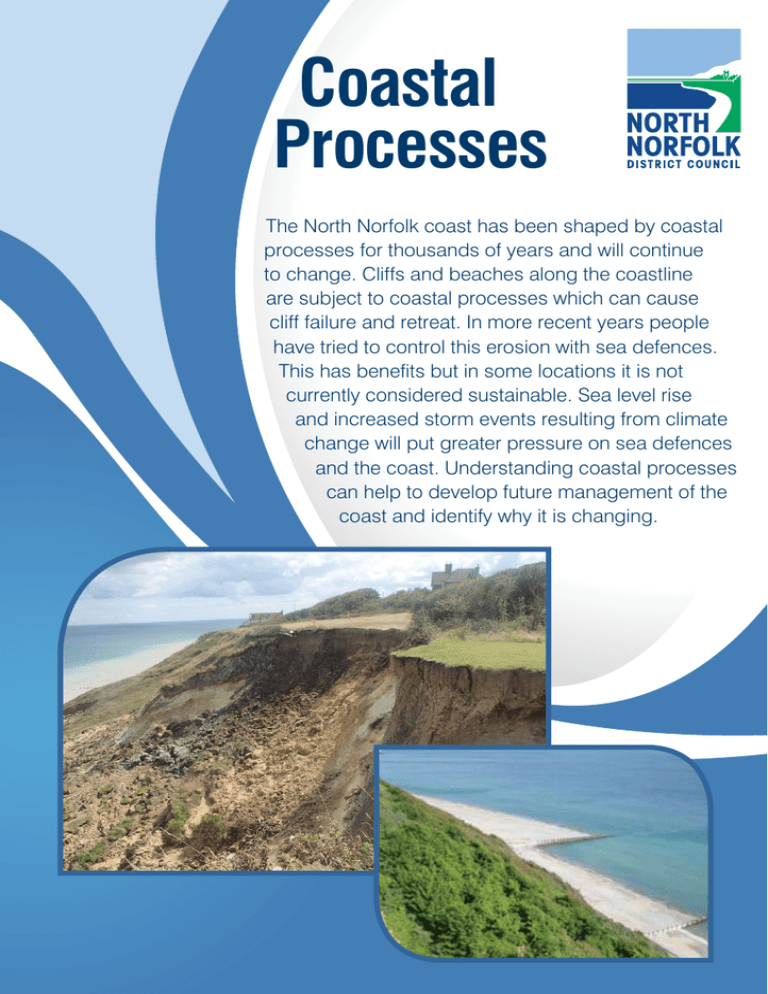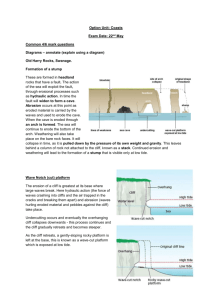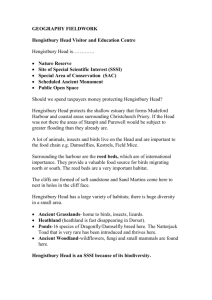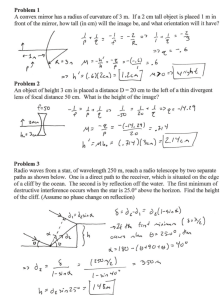Coastal Processes
advertisement

Coastal Processes The North Norfolk coast has been shaped by coastal processes for thousands of years and will continue to change. Cliffs and beaches along the coastline are subject to coastal processes which can cause cliff failure and retreat. In more recent years people have tried to control this erosion with sea defences. This has benefits but in some locations it is not currently considered sustainable. Sea level rise and increased storm events resulting from climate change will put greater pressure on sea defences and the coast. Understanding coastal processes can help to develop future management of the coast and identify why it is changing. Coastal erosion is the process of cliff materials wearing away due to regularly being hit by waves. The cliffs in North Norfolk are made up of soft sands, silts, clays and gravels and are susceptible to erosion and failure. A key driver of this is the action of the waves, through four erosional types: Why do cliffs erode? Hydraulic Action The sheer force of the wave hitting the cliff causes air that is trapped inside to compress, which can weaken the whole cliff Solution Sea water can dissolve cliffs on the shoreline. Rocks that are likely to dissolve are soft rocks such as chalk Attrition Rocks carried with the waves hit against each other and break down into smaller, smoother rocks and pebbles; this creates different grades of beach materials. Abrasion Material such as rock and sand within the waves hit the cliff when the wave breaks against it and causes the cliff to be ground down Simple Cliff Erosion 1 2 Toe erosion destabilises cliff Stable cliff 3 Instability leads to cliff failure and erosion of the cliff toe 4 Continuing erosion removes material and cliff stabilises over time Cliff failure can be problematic for a number of reasons, including limiting beach access, and impacting on coastal communities; however the material released from cliff erosion is essential to maintain beach levels further down the coast. Simple cliff erosion at Happisburgh through the action of the sea Complex Cliff Erosion Collapse caused by wave action is supplemented on large cliffs by the impact of groundwater. Clay layers within the cliff become saturated with rain water and become impermeable to percolating rain water traveling down through the cliff. Complex cliffs at Sidestrand, with multiple slumps and toe erosion. Original cliff position Geological horizons within cliff Groundwater contributing to cliff failure through weight and interactions with clay layers Cliff toe erosion Following a cliff failure, whether it was caused due to the action of the sea or because of groundwater, the process will begin again. Well vegetated, stable cliffs at Mundesley with only occasional erosion and losses The water begins to pool within the cliff increasing the water pressure and weight of the cliff making it unstable. The only way this pressure in the cliff can be released is by mud slides, slumps and cliff failures. Why do beach levels change? Beaches are primarily made up from materials released from eroding cliffs. This material is moved along and deposited on the coast by waves and tides; beaches are not static. Beach levels in North Norfolk can fluctuate quite quickly, due to constructive (beach building) and destructive (beach reducing) waves. Wave type is dependent on wind direction and strength. On the North Norfolk coast, storm winds from the east and north tend to create destructive waves often causing beach levels to fall. In periods of more settled weather, constructive waves are more frequent and beach levels begin to increase. Beaches are also subject to longshore drift, a process of sediment transport caused by waves and tides. Material can be moved in four different ways: Traction Large material is rolled along the sea bed by the power of the waves Suspension Small material is carried along in the water, which can make it look cloudy Saltation Small pebbles or large sand is bounced along the sea bed, as the current is unable to keep larger material afloat for long Solution Minerals are dissolved in sea water and carried. It is invisible and can come from chalk or limestone cliffs. In North Norfolk, sediment generally moves westerly from Weybourne and easterly from Sheringham towards Great Yarmouth. The high cliffs from Overstrand to Mundesley provide a significant contribution to beach materials and therefore feed much of the East Norfolk beaches. Many years of coastal protection have led to less material being released onto beaches resulting in a general fall in beach levels. In turn, this exposes the cliff toe to further action of the sea and increases sea defence maintenance costs. For more information concerning the coast, visit www.northnorfolk.org/environment. Or contact the Coastal Management Team: Tel: 01263 516248 Email: Coastal.Management@north-norfolk.gov.uk l North Norfolk District Council Holt Road, Cromer, Norfolk, NR27 9EN If you would like this document in large print or an alternative format, please telephone 01263 516150 and we will do our best to help.






